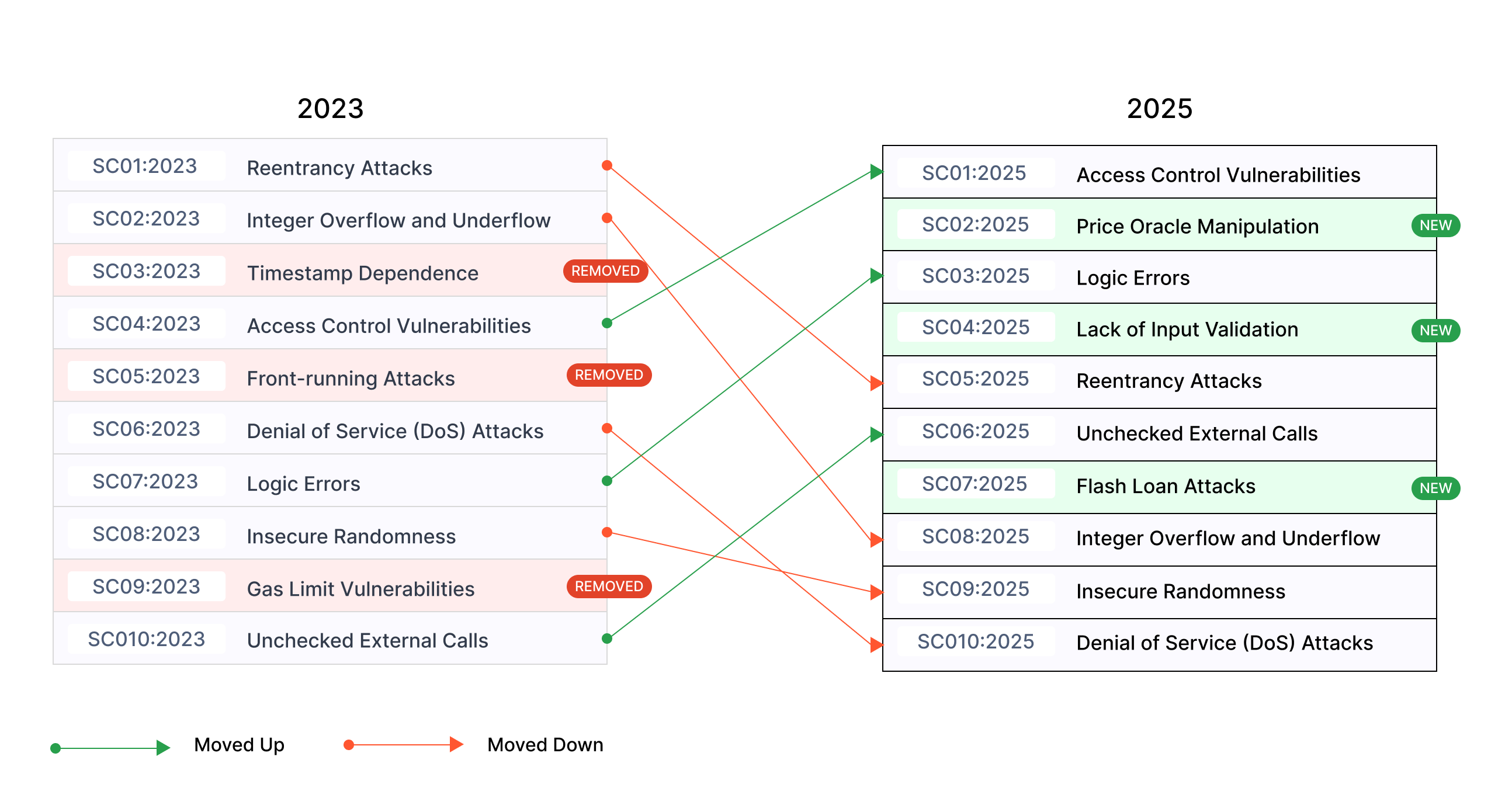OWASP Smart Contract Top 10

GitHub Repo
OWASP Project Page
The OWASP Smart Contract Top 10 is a standard awareness document that aims to provide Web3 developers and security teams with insights into the top 10 vulnerabilities found in smart contracts.
- Awareness: Understand the most common and critical vulnerabilities affecting smart contracts.
- Prevention: Implement best practices to safeguard against these known issues.
- Standard Compliance: A reference to ensure secure development and assessment of smart contracts.
- Security Audits: Use as a checklist for penetration testing and securing smart contracts.
It serves as a reference to ensure that smart contracts are secured against the most critical weaknesses exploited or discovered in recent years. The Smart Contract Top 10 can be used alongside other smart contract security projects to ensure comprehensive risk coverage.
Changes

Top 10
Overview
| Title |
Description |
| SC01 - Access Control Vulnerabilities |
Access control flaws allow unauthorized users to access or modify a contract's data or functions. These vulnerabilities arise when the code fails to enforce proper permission checks, potentially leading to severe security breaches. |
| SC02 - Price Oracle Manipulation |
Price Oracle Manipulation exploits vulnerabilities in how smart contracts fetch external data. By tampering with or controlling oracle feeds, attackers can affect contract logic, leading to financial losses or system instability. |
| SC03 - Logic Errors |
Logic errors, or business logic vulnerabilities, occur when a contract's behavior deviates from its intended functionality. Examples include incorrect reward distribution, token minting issues, or flawed lending/borrowing logic. |
| SC04 - Lack of Input Validation |
Insufficient input validation can lead to vulnerabilities where an attacker may manipulate the contract by providing harmful or unexpected inputs, potentially breaking logic or causing unexpected behaviors. |
| SC05 - Reentrancy Attacks |
Reentrancy attacks exploit the ability to reenter a vulnerable function before its execution is complete. This can lead to repeated state changes, often resulting in drained contract funds or broken logic. |
| SC06 - Unchecked External Calls |
Failing to verify the success of external function calls can result in unintended consequences. When a called contract fails, the calling contract may incorrectly proceed, risking integrity and functionality. |
| SC07 - Flash Loan Attacks |
Flash loans, while useful, can be exploited to manipulate protocols by executing multiple actions in a single transaction. These attacks often result in drained liquidity, altered prices, or exploited business logic. |
| SC08 - Integer Overflow and Underflow |
Arithmetic errors due to exceeding the limits of fixed-size integers can lead to serious vulnerabilities, such as incorrect calculations or token theft. Unsigned integers wrap around on underflow, while signed integers flip between extremes. |
| SC09 - Insecure Randomness |
Due to the deterministic nature of blockchain networks, generating secure randomness is challenging. Predictable or manipulable randomness can lead to exploitation in lotteries, token distributions, or other randomness-dependent functionalities. |
| SC10 - Denial of Service (DoS) Attacks |
DoS attacks exploit vulnerabilities to exhaust contract resources, rendering it non-functional. Examples include excessive gas consumption in loops or function calls designed to disrupt normal contract operation. |
Data Sources
SolidityScan's Web3HackHub:
To identify and validate the OWASP Smart Contract Top 10 vulnerabilities, we incorporated insights from multiple authoritative sources, with a notable focus on SolidityScan's Web3HackHub (2024). This resource provides a comprehensive database of blockchain-related incidents, offering valuable data on attack vectors, financial losses, and trends.
Web3HackHub documents breaches from 2011 onward, enabling analysis of evolving attack methods, the increasing sophistication of exploits, and lessons learned from each incident.
Key highlights from Web3HackHub for 2024 include:
-
Total Financial Impact: $1.42 billion lost across 149 documented incidents in 2024.
-
Top Attack Vectors (by frequency, total losses):
- Access Control Vulnerabilities: $953.2M in losses.
- Logic Errors: $63.8M in losses.
- Reentrancy Attacks: $35.7M in losses.
- Flash Loan Attacks: $33.8M in losses.
- Lack of Input Validation: $14.6M in losses.
- Price Oracle Manipulation: $8.8M in losses.
- Unchecked External Calls: $550.7K in losses.

Other Sources:
In addition to SolidityScan's Web3HackHub, incorporating insights from Peter Kacherginsky's "Top 10 DeFi Attack Vectors - 2024" provides valuable data for creating the OWASP Smart Contract Top 10 for 2025. Peter's analysis is instrumental in understanding the evolving threat landscape and aligning the OWASP Smart Contract Top 10 with real-world observations.
By integrating data from both SolidityScan's Web3HackHub and Kacherginsky's "Top 10 DeFi Attack Vectors - 2024," we were able to provide a well-rounded justification for the 2025 rankings.
After analyzing 149 security incidents from SolidityScan's Web3HackHub (2024), Peter Kacherginsky's "Top 10 DeFi Attack Vectors - 2024", and the Immunefi Crypto Losses in 2024 Report, which collectively document over $1.42 billion in financial losses across decentralized ecosystems, the OWASP Smart Contract Top 10 for 2025 was created to address the most critical vulnerabilities in the blockchain and smart contract ecosystem.
Licensing
The OWASP Smart Contract Top 10 (2025) is licensed under the CC BY-NC-SA 4.0, the Creative Commons Attribution-ShareAlike 4.0 license. Some rights reserved.